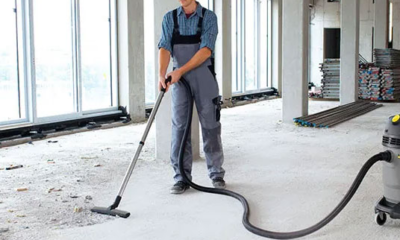Lifestyle
Trail Running Shoes for Different Types of Terrain: Mud, Rocks, and More
Published
2 years agoon
By
Robert King
Trail running is an excellent way to enjoy the great outdoors and stay fit, but it requires specific gear to keep you comfortable and safe. The most important gear for a trail runner is a good pair of trail running shoes. These shoes are designed to offer stability and traction on even the most uneven terrain, making them important for anyone who wants to tackle the trails.
In this article, we will explore the different types of running shoes and how they work for different kinds of terrain, including mud, water and rocks.
Trail running shoes for muddy terrain
There are trail running shoes specifically designed for muddy conditions. If you have ever tried running on a muddy trail with regular running shoes, you know how challenging it can be to maintain your footing.
Trail running shoes that are made for muddy terrain feature aggressive lugs that dig into mud and prevent slipping, providing you with the stability you need to navigate this treacherous terrain. These trail running shoes also often have a wider forefoot to prevent mud from caking up and affecting traction, which can be a real problem if you’re running in thick mud.
Trail running shoes for wet terrain
There are trail running shoes specifically designed for wetter conditions, offering traction on slippery and wet surfaces.
These kinds of trail running shoes are ideal for runners who constantly encounter water crossings or run over wet rocks. Water shoes typically have mesh uppers to allow water to drain out easily, preventing the shoes from getting waterlogged and heavy. They’re also made of materials that dry quickly, so you don’t have to worry about running with squishy, uncomfortable shoes.
Trail running shoes for rocky terrain
Trail running shoes designed for rocky terrain offer extra protection and stability in the outdoors.
Running on rocks can be tough on your feet, and without the right shoes, you run the risk of injuring yourself.
These kinds of trail running shoes typically have a reinforced toe box and a stiffer sole to protect the feet from sharp rocks. The lugs on rock shoes are usually less aggressive than those on mud shoes to provide better grip on rock surfaces.
All-Around trail running shoes
All-around trail shoes are designed to perform well on a variety of terrains, from mud to rocks to packed dirt. These shoes are versatile and often have a moderate level of cushioning to provide comfort and support on longer runs. All-around trail shoes typically have a more versatile lug pattern that can handle a variety of terrains without sacrificing traction or stability.
Hoka Trail Running Shoes for all terrains
Hoka is a popular brand of trail running shoes known for their maximalist design. Hoka shoes feature thick cushioning that provides exceptional shock absorption and support, making them a great choice for runners who need extra comfort on long runs. Hoka trail running shoes also have a unique Meta-Rocker technology that promotes a natural rolling motion, which can help reduce fatigue and increase efficiency.
Hoka shoes are versatile and can handle a variety of terrains, from mud to rocks to packed dirt. One of the most popular Hoka trail running shoes is the Speedgoat, named after ultra-runner Karl “Speedgoat” Meltzer. This shoe features a durable and protective upper, a Vibram outsole that provides excellent traction on all terrains, and a comfortable midsole that delivers a smooth ride. Overall, Hoka trail running shoes are an excellent choice for runners who prioritize comfort and support in their footwear.
In Conclusion
Trail running shoes are an essential piece of gear for any trail runner. Whether you’re navigating muddy trails, crossing streams, or running on rocky terrain, having the right pair of shoes can make all the difference in your performance and safety. With so many options on the market, it’s important to choose the right shoe for your specific needs to ensure a comfortable, safe, and enjoyable trail running experience.
Recent News


Instagram Story Viewer: Shaping Social Media!
Could you think of Instagram without stories? Even though Instagram Stories were introduced not so long ago, in 2016, they...


Top Benefits of Using a Phone Appending Platform for Batch Data Updates
In the world of data-driven marketing, having access to accurate and current contact information is essential for successful customer outreach....


3 Tips for Dressing Perfectly for Special Occasions
Dressing for special occasions can sometimes be a stressful and overwhelming process, especially for women. Whether you’re attending a wedding,...


Maximise Your Hunting Success with Dive Bomb Industries Decoys
When it comes to hunting, there’s no such thing as too much preparation. Hunters understand that the right equipment can...


Castle App Free Download — Updated 2024 Version
What is Castle App? Castle App, a stream app developed for streaming media content, makes entertainment effortless by giving clients...


How to get a duplicate RC book for your vehicle: A step-by-step guide
If you have lost or damaged your vehicle’s registration certificate, you must be tense and under stress. But getting a...


Enhancing Property Value Through Professional Builders Cleaning Services in the UK
Construction and renovation projects make a ton of residue, garbage, and soil, passing on a requirement for proficient cleaning to...


Saturn in Sidereal Pisces-March 28,2024 to February 21st 2028 by Jade Luna
I really wanted a female president governing this cycle but the chart of America would choose the hardest path, not...


Top 5 Super Clone Rolex for Women
Super clone Rolex watches are incredibly detailed knock-offs of popular Rolex models, crafted to look and feel just like the...


Transforming Dreams into Reality: A Success Story of Purchase Amazon Seller Account
Purchase Amazon Seller Account: In the fast-paced world of e-commerce, many aspiring entrepreneurs dream of starting their own business. However,...
